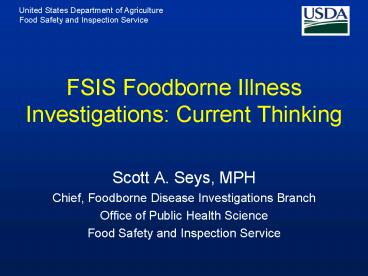FSIS Foodborne Illness Investigations: Current Thinking - PowerPoint PPT Presentation
1 / 31
Title:
FSIS Foodborne Illness Investigations: Current Thinking
Description:
Take appropriate action to prevent further exposure to consumers ... Locate or detain product. Collect product samples for testing ... – PowerPoint PPT presentation
Number of Views:48
Avg rating:3.0/5.0
Title: FSIS Foodborne Illness Investigations: Current Thinking
1
FSIS Foodborne Illness Investigations Current
Thinking
- Scott A. Seys, MPH
- Chief, Foodborne Disease Investigations Branch
- Office of Public Health Science
- Food Safety and Inspection Service
2
FSIS Investigations
- Multifaceted, multidisciplinary undertaking
- Three-Legged Stool of Investigations
- Environmental Health
- Epidemiology
- Laboratory
3
FSIS Investigation Objectives
- Determine whether human illnesses are associated
with FSIS-regulated products - Identify source of production, distribution
- Gather information to guide response
- Take appropriate action to prevent further
exposure to consumers
4
FSIS Investigation Objectives
- Initiate enforcement action as appropriate
- Identify contributing factors
- Report on results of investigation
- Recommend steps to prevent future occurrences
5
Investigations are Unique
- Components outlined generally in presentation
- Phases of investigations may occur nearly
simultaneously - Flow of information and data is dynamic
6
Epidemiology
7
Applied Epidemiology Division
- Applied Epidemiology
- Application and evaluation of epidemiologic
methods - Epidemiologic practice aimed at
protecting/improving health of a population - Two Branches
- Foodborne Disease Investigations Branch
- Zoonoses and Food Hazards Surveillance Branch
Last, A Dictionary of Epidemiology, fourth
edition
8
Foodborne DiseaseInvestigations Branch
- Coordinate FSIS foodborne illness investigations
- Collaborate with public health partners to
investigate illnesses potentially associated with
FSIS-regulated product - Serve as liaison between public health partners
and FSIS specialty personnel
9
Public Health andEpidemiology Liaisons
10
FSIS Surveillanceand Information Monitoring
- Local, state, territorial public health
- CDC via FSIS Liaison to CDC
- Other federal agencies (FDA, NPS, etc.)
- Internal foodborne illness and hazards
surveillance - Consumer complaints, PFGE clusters
- Media reports
11
Assessment of Preliminary Data
- Does available information suggest a link between
product and illness? - Are methods scientifically valid?
- Are preliminary findings plausible?
- Do preliminary epidemiologic, laboratory, and
environmental findings correlate? - Do literature and past experiences support
preliminary findings?
12
Initiating an FSIS Investigation
- Initial alert to FSIS program areas for early
notification - Weekly FSIS investigations meeting
- Assess criteria for non-routine incidents
13
Deliberate Contamination
- Potential non-routine incidents immediately
reported and supplemental protocols followed - Managed by Emergency Management Committee (EMC)
- Incident Commander from Office of Food Defense
and Emergency Response
14
Laboratory
15
FSIS Laboratories
16
Product Sampling Assessment
- Do available data support a link between product
and illness? - Is product available meeting FSIS criteria for
product identity, chain of custody, product
handling? - Has a non-FSIS laboratory tested product?
- Can testing be performed by, or in association
with, FSIS?
17
Non-Intact Product
- Product with opened packaging or product removed
from original packaging - May be in commerce or consumers home
- Useful when intact product is not available and
when additional information is needed to
determine whether a link exists - Testing results can result in Agency action
18
Non-Intact ProductSampling Assessment
- How was non-intact product handled by
case-patient? - Was non-intact product stored properly?
- Are packaging materials and product labels
available? Can product identity be ascertained?
19
Use of Pulsed-FieldGel Electrophoresis (PFGE)
- All PFGE patterns derived from FSIS foodborne
illness investigations and recall isolates
uploaded to PulseNet - Recall watch to ensure adequate scope
- PFGE from FSIS E. coli O157, Listeria RTE, and
Salmonella RTE product testing uploaded to
PulseNet - PFGE from FSIS Salmonella raw product testing
accessible through VetNet
20
Environmental Health
21
OFO District Offices andOPEER Regional Offices
22
Product in Commerce
- Office of Program Evaluation, Enforcement and
Review - Traceback or traceforward of product
- Locate or detain product
- Collect product samples for testing
- Environmental assessment of facilities
- Coordination with Office of Field Operations and
public health partners
23
Product in Establishment
- Office of Field Operations
- Traceback or traceforward of product
- Locate or detain product
- Collect product samples for testing
- Gather information about production practices
- Perform assessments
- Coordination with Office of Program Evaluation,
Enforcement and Review
24
Three-Legged Stool(putting it all together)
25
Data Analysis and Assessment
- Data collection and analysis, assessment of
findings are ongoing throughout investigation - Strength of association is measured using
established epidemiologic principles - Framework based on Procedures to Investigate
Foodborne Illness
26
Framework for Assessment
- Descriptive Information
- Time sequence
- Plausibility
- Dose-response
- Consistency
- Disease confirmation, laboratory analyses
- Analytical studies
27
Is there credible evidenceto support an
association between human illness and an
FSIS-regulated product?
28
Agency Action
- Recall committee convened to discuss findings of
the investigation - Agency action is not just voluntary recalls,
other examples include - Increased/enhanced inspection
- Increased frequency of microbial sampling
- Issuance of a public health alert
29
Agency Action
- Congressional and Public Affairs Office leads
public communications efforts - Communication to affected local, state,
territorial public health officials - Investigation ongoing to ensure actions are
sufficient in scope
30
After-Action Activities
- Analyze what occurred and corrective and
preventive actions taken by establishment - Assess changes Agency may take to reduce
possibility of repetition of circumstances
leading to Agency action - Address data gaps
- Coordinate FSIS close-out call
31
Summary and Lessons Learned
- FSIS foodborne illness investigations are
multidisciplinary and involve numerous program
areas - Substantial coordination and collaboration are
essential between local, state, and federal
public health partners































